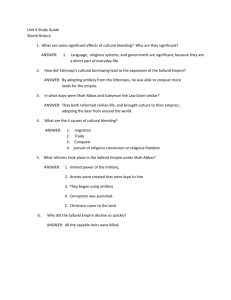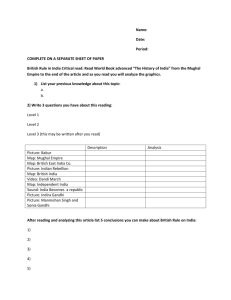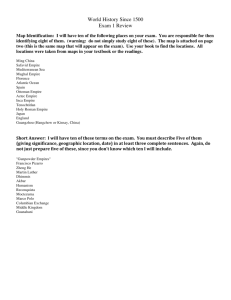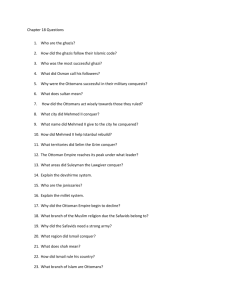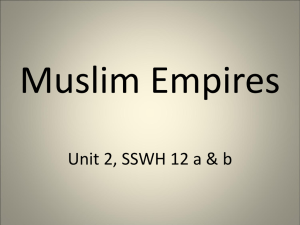The Muslim World Expands
advertisement
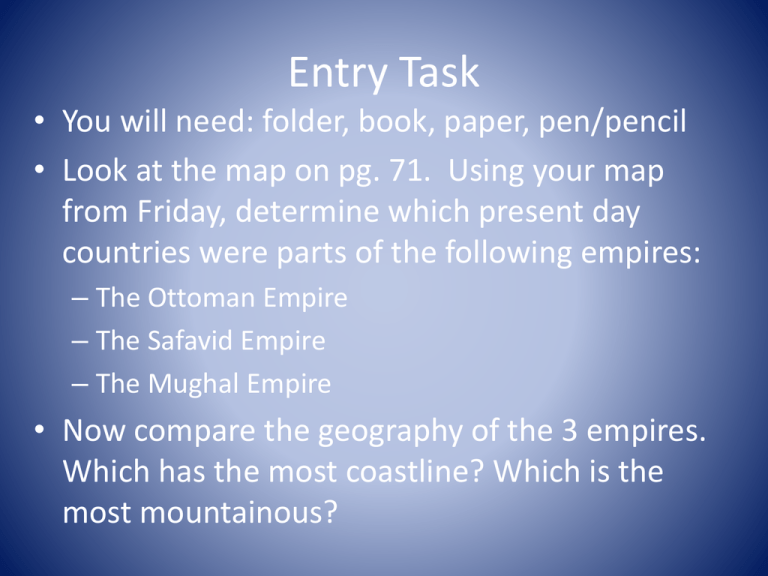
Entry Task • You will need: folder, book, paper, pen/pencil • Look at the map on pg. 71. Using your map from Friday, determine which present day countries were parts of the following empires: – The Ottoman Empire – The Safavid Empire – The Mughal Empire • Now compare the geography of the 3 empires. Which has the most coastline? Which is the most mountainous? The Muslim World Expands 1300-1700 What should I learn today? • Basic understanding of Islam • Understanding of 3 Muslim Empires • Connections to Today What does it mean to be a Muslim? • Muslims (or Moslems) are followers of Islam • Islam is one of the world’s 3 main monotheistic religions (along with Christianity and Judaism) – Monotheistic: belief in one god • Dominant religion in the Middle East, North Africa and parts of Asia • Over 1.5 billion worldwide • Two major divisions: Sunni and Shi’a Important Facts • God: Allah, means “god” in Arabic • Holy Book: Qur’an/Koran • Place of Worship: Mosque • Holy Cities: Mecca, Medina, Jerusalem • Important People: Prophet Muhammad – Also: Abraham, Moses and Jesus 5 Pillars of Islam • Belief in one god, Allah, and his prophet, Muhammad • Daily prayers, 5 times each day • Giving to those in need based on personal wealth • Purification through fasting during the month of Ramadan • The Hajj, a pilgrimage to the city of Mecca Empire Builders in the Middle East and South Asia • The Ottomans • The Safavids • The Mughals The Ottoman Empire: Turks Move into Byzantium • Anatolian Turks: ghazis, warriors for Islam • Formed military societies and invaded the territories of infidels, people who did not believe in Islam • Osman: successful ghazi, his followers were called Ottomans • Success and expansion until stopped by Timur the Lame The Ottoman Empire: Powerful Sultans Spur Dramatic Expansion • 4 powerful sultans led Ottoman Empire until 1566 • 1453: took Constantinople (now Istanbul, Turkey) under Mehmed the Conqueror • 1514: defeated the Safavid under Selim the Grim – Continued on to take Mecca, Medina and Cairo The Ottoman Empire: Suleyman • Suleyman the Lawgiver and Suleyman the Magnificent • Continued to expand the empire into Central Europe, North Africa and Central Asia • Structured social organization: law code, simplified taxes and government • Tolerance of religious and cultural differences Mosque of Suleyman Istanbul, Turkey The Ottoman Empire: The Empire Declines Slowly • Pattern of gaining power and holding power • The practices of the sultans led to weak leaders and the decline of the empire – Suleyman killed his most capable son and sent another into exile – Selim II inherited the throne Building the Safavid Empire • Major influences: Persians, Ottomans, Arabs • Located between the Ottoman Empire and the Mughal Empire • Strong military force • Leader Isma’il became a religious tyrant and controlled Persia, (now Iran) and took the ancient Persian title of shah (meaning king) • Defeated by Ottomans in 1514, set present day border between Iraq and Iran The Safavid Empire Golden Age • Shah Abbas, also called Abbas the Great, helped create a Safavid culture that drew from the best of the Ottoman, Persian and Arab worlds • Reforms and respect for military and civilian life • Tolerance for other religions and cultures – Encouraged industry, trade and art exchanges with European nations • Built a beautiful new capital at Esfahan with influences from all over Europe and Asia Esfahan, Iran The Safavid Empire: The Dynasty Declines Quickly • Story is similar to that of the Ottomans… • Shah Abbas killed or blinded his ablest sons • The pampered young prince Safi led the empire into decline • In 1736 Nadir Shah Asfar once again created an expanded empire but was assassinated in 1747 and the empire fell apart The Mughal Empire: Early History • History of being divided • Delhi destroyed by Timur the Lame in 1398 • 1494: Babur moved south and laid the foundation for the Mughal Empire The Mughal Empire: Akbar’s Golden age • Akbar, means “Greatest One” • Ruled with wisdom and tolerance from 15561605 • “A monarch should ever be intent on conquest, otherwise his neighbors rise in arms against him.” • With one neighbor, discuss what you think this means The Mughal Empire: Akbar’s Golden Age • Combination of military power and political wisdom • Unified a land of at least 100 million people • Ruled with tolerance, allowed religious freedom and allowed all to rise in political power • Cultural blending affected language, art, education, architecture and politics The Mughal Empire: Akbar’s Successors • Jahangir: the son of Akbar left the political power in the hands of his wife, the Persian princess Nur Jahan • Shah Jahan: killed all possible rivals, built the Taj Mahal after the death of his wife, Mumtaz Mahal – Taxes supported beautiful buildings but people suffered •Aurangzeb ruled oppressively and lost power The Mughal Empire: Decline and Decay • • • • • Aurangzeb drained the empire’s resources People had little loyalty to him Over 2 million died in famine Gave Bombay to the British in 1661 Empire became less and less united after his death • Next conquerors… Europeans
